Archive for Maintenance
July 17, 2008 at 9:04 am · Filed under Home base, Maintenance
It turned out to be an all-day session in Plattsburgh yesterday. Things started out well: Colin’s crew had my new catalytic heater installed fairly quickly. At last we have an alternate source of heat in the trailer for boondocking. The catalytic heater uses no electric power at all, and converts propane to heat with 100% efficiency, which is vastly better than the furnace.
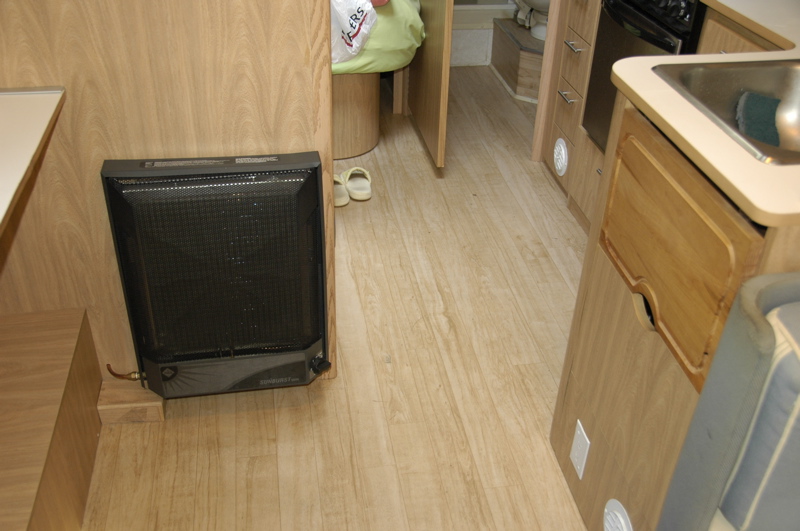 Despite being the largest “cat” heater I could get, the unit fits nicely in a spot right in the center of the Airstream. It is hung on the wall, looking like a black monolith from 2001: A Space Odyssey where it won’t interfere with traffic flow and uses a relatively “dead” space. For a catalytic heater in a long trailer, a center location is ideal because the heat it produces needs to be distributed by natural air flow through the trailer.
Despite being the largest “cat” heater I could get, the unit fits nicely in a spot right in the center of the Airstream. It is hung on the wall, looking like a black monolith from 2001: A Space Odyssey where it won’t interfere with traffic flow and uses a relatively “dead” space. For a catalytic heater in a long trailer, a center location is ideal because the heat it produces needs to be distributed by natural air flow through the trailer.
It works like this: We will open a center window near the heater to let cool air from outside spill down to the floor. This air will be warmed by the heater and rise up. Slightly opened roof vents at front and rear will create a natural flow through the trailer and bring the warm air to all parts of the trailer. We know this works because it’s exactly the system we used to keep our former Argosy 24 warm.
The heater we’ve chosen produces 9,000 btus, which is far less than the 30,000 btu furnace that came with the Airstream. But that’s no problem, because a catalytic produces heat silently and steadily as long as it is “lit”, whereas the furnace cycles on and off. We used a 6,000 btu model in our 24 foot trailer and it could always keep the trailer warmer than we needed. Since these heaters don’t have thermostats (but rather just a Low-Medium-High dial), you regulate the temperature by opening the roof vents a bit more or less.
I’m a big fan of catalytics, having used them in two prior trailers with great results. The only real disadvantages of the catalytic are that they produce moisture and consume oxygen. For both problems you must have a window and roof vent partially open. Nine square inches of opening is recommended for this particular model, which isn’t as much as it might seem. And as I mentioned, opening the window and vent is the way you distribute the heat anyway.
The one remaining potential issue is that the catalytic heat won’t reach the holding tanks. Most modern Airstreams come with ducts to direct furnace heat to the tanks, to prevent freezing in really cold weather. Using only the catalytic heater we run the theoretical risk of a frozen tank but in reality we’ve never camped in temperatures sufficient to freeze a tank. An overnight low of 25 degrees (with above-freezing temperatures during the day) has never managed to freeze our tanks, and if the overnights are colder than that, I know how to drive south.
There’s usually a payback due to Colin for the work he does on my trailer. He is brilliant with mechanical things, and hopeless with computers and software. I’m just the opposite, so when he fixes my trailer I try to pay back with something he needs. In this case he wanted his email system fixed (on three computers) so it would send email reliably without getting “bounce” messages due to other people’s spam filters, he needed  Microsoft Office installed on one computer, an external wifi card installed on Susanne’s computer, and cable Internet installed in his house with a wifi router. None of those are normally difficult tasks if you know what you’re doing, but Microsoft and the local cable company did manage to make everything harder than it had to be. By the time we’d been to Best Buy, the cable company local office, the shop, and his home, and installed everything, it was 6 p.m.
Microsoft Office installed on one computer, an external wifi card installed on Susanne’s computer, and cable Internet installed in his house with a wifi router. None of those are normally difficult tasks if you know what you’re doing, but Microsoft and the local cable company did manage to make everything harder than it had to be. By the time we’d been to Best Buy, the cable company local office, the shop, and his home, and installed everything, it was 6 p.m.
 At the end of it all I was glad to be rolling down the road again, headed to home base with leaks fixed and heater installed. Lake Champlain was glassy calm and hardly anyone was on the ferry. The Airstream just seemed to serenely float across the lake on the top of the ferry platform, enjoying its semi-private ride past cruise boats and jumping trout, while the sun slowly set over the Adirondacks. I’ve parked it in the usual spot and set up camp for the next two weeks.
At the end of it all I was glad to be rolling down the road again, headed to home base with leaks fixed and heater installed. Lake Champlain was glassy calm and hardly anyone was on the ferry. The Airstream just seemed to serenely float across the lake on the top of the ferry platform, enjoying its semi-private ride past cruise boats and jumping trout, while the sun slowly set over the Adirondacks. I’ve parked it in the usual spot and set up camp for the next two weeks.
July 16, 2008 at 10:00 am · Filed under Maintenance
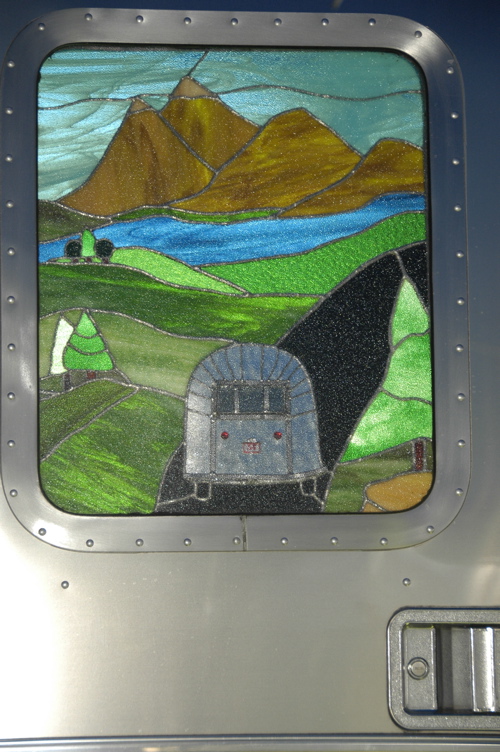 After the Jam I had planned to get some maintenance done on the Airstream up at Colin’s shop in Plattsburgh NY, before returning to home base in Vermont. The cost of taking the trailer across Lake Champlain is now up to $65 round-trip, plus about $35 in fuel, so I didn’t want to make the trip again later in the month. On Tuesday morning I dropped Brett at the Albany airport (Airstream in tow, much to the surprise of the outdoor personnel), and headed 130 miles up to Plattsburgh.
After the Jam I had planned to get some maintenance done on the Airstream up at Colin’s shop in Plattsburgh NY, before returning to home base in Vermont. The cost of taking the trailer across Lake Champlain is now up to $65 round-trip, plus about $35 in fuel, so I didn’t want to make the trip again later in the month. On Tuesday morning I dropped Brett at the Albany airport (Airstream in tow, much to the surprise of the outdoor personnel), and headed 130 miles up to Plattsburgh.
The list of items to be tackled was fairly simple. In the thunderstorms of the past few weeks I’ve noticed a small leak at the dinette window, and in the heavy rain at the Jam on Sunday night we found a second leak at the curbside bedroom window. We’d had the Seal-Tech leak test done a year ago, but clearly with heavy use this is a procedure that needs to be done annually.
I also have had a catalytic heater waiting to be installed for months. We really felt the need for it last fall when we were camping in Yellowstone, Banff, and Yosemite and we were living on a tight power budget. We’ve chosen a 9000-btu model, sufficient to heat the entire trailer.
I have found that the Seal-Tech system is not perfect. There are some air leaks that it will reveal (via soap bubbles) that are not really places water is likely to infiltrate, and there are some leaks it will not reveal. This means there’s no substitute for a sharp eye and experience. One leak was not hard to find, but the other took a bit of sleuthing. They’re both fixed now, we think.
There wasn’t time to get to the catalytic heater yesterday, so I towed the Airstream over to Colin’s house and spent the night in the driveway. While I was there, Colin took a look at a loose bracket under the Armada and received a very small shock while lying on the damp grass and touching the Armada. We added a possible “ground fault” to the list of things to check, but when I got back to the shop this morning, testing revealed that the ground fault was probably coming from the house wiring (to the Airstream, and through the hitch to the Armada). The Airstream seems to check out fine.
This was interesting to me. I carry two testers to verify the wiring of outlets we plug into, and both indicated no problem. At the shop, we also found a small voltage leak (0.2 volts AC) that was again originating from the power being supplied to the Airstream. Apparently such a small leak is below the threshold of the basic testers I carry.
Eleanor and Emma have been back in Vermont patiently waiting for me to return with their bedrooms. I should be done here by the end of the day. In the meantime, there are a few tasks to resolve with the Fall 2008 magazine, and a bunch of post-Jam jobs to be done. Once those are complete, I’ll be working on the Caravel re-build again, and planning our westward trip, scheduled to start around August 2-4.
July 4, 2008 at 10:23 pm · Filed under Home base, Maintenance
 The week before a major Airstream event is often a busy time for me, and this week is an exceptional one even by that standard. That’s because this time the event is one which I’m co-organizing, and that means a lot of last-minute details to be managed. Add in my attempt to start rebuilding the entire interior of our 1968 Airstream Caravel, two guests staying in the Airstream with us (Brett and now Lori, who flew in last night), last-minute work on the Fall issue of the magazine, and then the complete & sudden failure of our refrigerator … well, you can see how things are a bit hectic.
The week before a major Airstream event is often a busy time for me, and this week is an exceptional one even by that standard. That’s because this time the event is one which I’m co-organizing, and that means a lot of last-minute details to be managed. Add in my attempt to start rebuilding the entire interior of our 1968 Airstream Caravel, two guests staying in the Airstream with us (Brett and now Lori, who flew in last night), last-minute work on the Fall issue of the magazine, and then the complete & sudden failure of our refrigerator … well, you can see how things are a bit hectic.
The day Brett arrived by air, I picked him up in the morning and we immediately headed over to the hardware stores to get supplies for the Jam. Then we dropped by Sterling Hardwood to pick up the Caravel project wood (11 sheets of plywood and lots of lengths of ash hardwood cut to various sizes), and by the time we were done unloading at 4 p.m., I noticed the bleeding refrigerator.
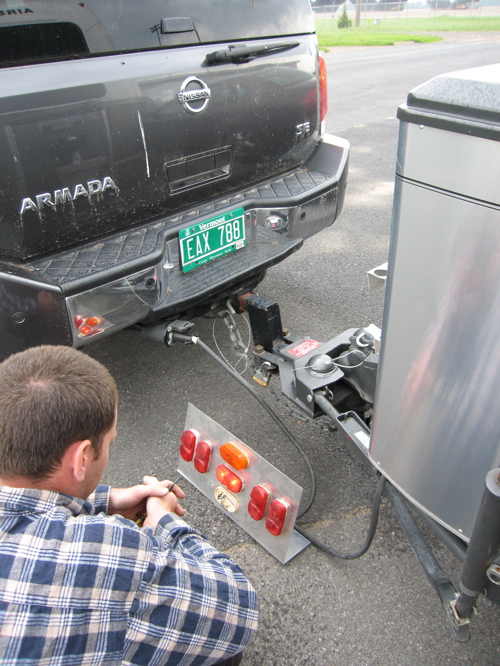
Yesterday was about the same. At Colin Hyde’s shop we got the new Dometic refrigerator installed, which is a major relief and a substantial upgrade. The new refrigerator has about 25% more useful space inside, and more importantly, it isn’t bleeding coolant.
While we were there, somebody noticed that the trailer’s right brake and turn signal wasn’t working. We isolated this to the Nissan easily, using a light testing rig that Colin’s guys made up. You can see it in the picture. Digging around the Armada, we discovered there isn’t a specific fuse for the trailer lights but there are relays, which we couldn’t test. So off it goes to the dealer on Tuesday.
We also discovered that there’s a Technical Service Bulletin which is possibly related to this issue, involving the need for a new Body Control Module (think, “computer”). We’ll find out on Tuesday if the cause is simple or not, but either way it needs to be ready to tow to the Jam on Wednesday.
Then we hauled the Airstream back to Vermont, dumped the tanks and refilled the propane at a nearby campground, and got parked again by 7 p.m. After dinner and early this morning, I squeezed in a little time to review layouts for the magazine and reply to email. Late last night Brett went to the airport to pick up Lori and then we were four in the Airstream (with Emma sleeping in the house with my parents).

Today we took a break, mostly. We had Colin and his son over for the Fourth of July, under spectacular clear skies and fine temperatures. The humidity has broken at last, and the thunderstorms have relented. We got the sort of weather that makes Vermonters forgive the state for the awful conditions they’ve experienced lately. So a little boating, a lot of conversation, a grilled dinner, and a late sunset have given us a nice break from the pressure of being ready for next week. We have a long way to go before we can rest easy, but I think we’ll be ready for the Jam by Wednesday.
July 2, 2008 at 10:01 pm · Filed under Maintenance
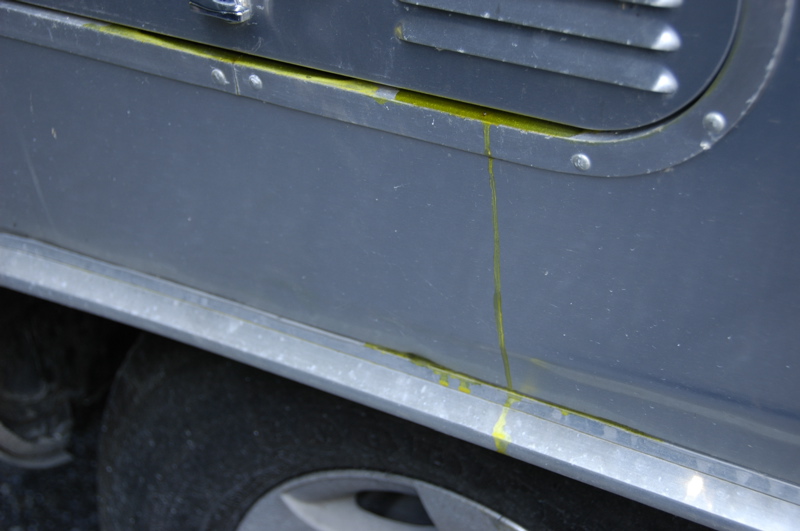
If you walk past your fridge compartment and see this yellow stain, what should you think?
I’ll give you a hint. The yellow stuff is the refrigerant that normally circulates through the refrigerator’s cooling unit like blood through your veins. So if you saw someone bleeding like this, what would you think?
You’d probably think what I thought: “Uh-oh,” followed by several other unpleasant things. Because this is not a Band-Aid type of injury. This yellow liquid pouring from the refrigerator compartment is more akin to a major chest wound. For the refrigerator, it is fatal.
This morning I left around 10 a.m. to pick up Brett at the airport. He’s staying with us a few days before we head off to the Vintage Trailer Jam next week. We spent the day picking up supplies we’ll need at the Jam, had a nice lunch out at Henry’s Diner (a Burlington Vermont fixture for 80 years), and also picked up the wood for the Caravel project.
When we returned, I glanced at the refrigerator compartment and found the grim sign above. Our refrigerator had suddenly blown an artery and died while we were away.
It didn’t just spring a little leak like most refrigerators do when they are beginning to lose it. Those leaks leave a little residue of yellow powder, which is the dried residue of the coolant. Ours failed catastrophically with a big leak all at once.
I know it happened suddenly because I’ve been checking our refrigerator compartment weekly. I’ve known for a few weeks that our refrigerator was included in a recall by Dometic, for a problem that which is said to affect 0.1% of refrigerators in the recall. The issue is that a fatigue crack can form in a coolant tube near the burner. When running on propane, it is possible for a fire to start, and apparently this happened to a few refrigerators. Dometic’s website advised us to shut off the refrigerator (not an option for us), or at least run it exclusively on electric until the recall service could be performed.
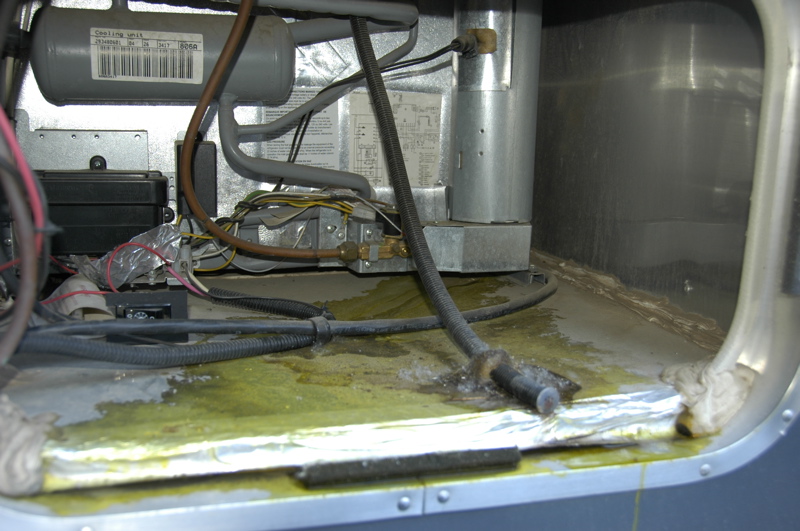 We’ve been running our refrigerator only on electric since we arrived in Vermont, but to be safer I have been checking the refrigerator weekly for tell-tale yellow signs of a leak. Up until today, I saw nothing. And then this.
We’ve been running our refrigerator only on electric since we arrived in Vermont, but to be safer I have been checking the refrigerator weekly for tell-tale yellow signs of a leak. Up until today, I saw nothing. And then this.
My plan was to have the recall service done at Colin Hyde’s shop immediately after the Trailer Jam. But time was against me on this one. Interestingly, if I had gotten the recall done, it would have made little difference. The recall doesn’t prevent the crack from forming (nor prevent a leak from occurring). It simply contains any leak that might occur, to prevent a fire.
At this point the refrigerator is officially dead. We got three years of full-time use out of it, which is less than I would have liked, but still quite a lot of use. We almost never turned it off. It can be brought back to life with an expensive repair, probably in the form of a replacement cooling unit. But instead of fixing it, we are going to install our spare refrigerator. (Yes, we own a spare refrigerator. Doesn’t everybody?)
Honestly, it just happens that through a series of events far too complex to explain here, we happen to own a brand-new Dometic NDR1062 refrigerator and it has been sitting up in Plattsburgh waiting for us. It’s the same size as our existing refrigerator, but has more interior space due to an advanced insulation design. We had one in our 1977 Argosy (“Vintage Thunder”) and loved it. I had been planning to upgrade our refrigerator eventually and just never got around to it.
We are lucky that our dear friend Colin is willing to take an hour or two out of his extremely busy pre-Jam schedule and install the new fridge on short notice. So we’ve mopped up all the leaking coolant, off-loaded all the food, and of course shut down the refrigator. Tomorrow Brett and I will tow the Airstream up to Plattsburgh and help Colin do the swap. If all goes well, we’ll be back in Vermont in the afternoon, with a couple of cold cans chilling in the new refrigerator.
May 28, 2008 at 9:08 pm · Filed under Maintenance
The past 48 hours have reminded me of the difference between good and bad service. We brought our Safari into Colonial Airstream to have a leak repaired on our front compartment. When we tow in wet conditions, water gets into the front compartment. This problem has been plaguing us for over a year, and nobody has been able to solve it.
Our solution has been to put packing tape over the door frame, which has stopped the wind-driven water from blowing in. But it’s not an elegant solution and so finally we brought it to Colonial Airstream for a real repair.
Tony Cursi, Service Manager, has been absolutely great. The week before we came in, he requested digital photos of the area so he could plan the solution. Then he got on the phone with Airstream’s service experts and got their advice. When we arrived, he had parts on hand and spent time with me to review his ideas even before we were unhitched.
In the end, the solution was to remove the compartment door, re-attach it a bit straighter than it was originally made, add reinforcing metal behind the lower corners to eliminate some cracking that was happening there, re-riveting, caulking, adjusting the gasket, and doing other sealing work along the lower edge. Tony thinks the solution will prevent further leaks, and I’m hoping he’s right.
Bottom line: the work got done professionally, they worked with me to come up with a good solution, and the job was done quickly. If that was the end of the story we’d have left today and headed on our way. But we still needed a fix for the Nissan’s hitch.
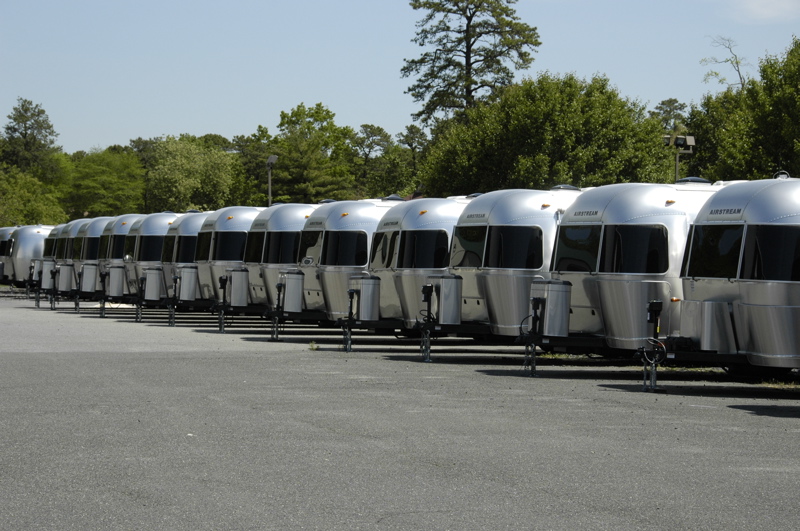
Let’s contrast my customer service experience with the Nissan dealership I took our Armada today. Our hitch was suffering a problem of two forward bolts coming loose inside the frame. This is admittedly a tricky problem, but we hoped that if anyone could handle it, the dealer could. But when we dropped off the truck, the service writer looked unhappy about it and said, “I’ll see what I can do.” I also asked them to change the oil since we were there.An hour later he called to tell us that the bolts could be tightened for $50. He also said we needed a coolant flush, transmission and rear differential fluid replacement, an engine air filter, in-cabin microfilter, air conditioning “service” (a recharge), an alternator drive belt, and had a leaking rear differential seal. Except for the air conditioner, belt, and leaking seal, that’s basically a 60k service interval which we just had done 6,000 miles ago. It’s a $700 pile of services.
I was annoyed because every Nissan dealer we’ve visited has had full access via computer to our service records, and it was obvious that they were just trying to pad our bill with a heap of stuff we didn’t really need. I should have just bailed out and gotten the essential services elsewhere, but I told them to go ahead on the things we really needed: the belt, air conditioner recharge, and leaking seal (the latter covered by warranty).
They’ve made me regret that. The car was dropped off at 12:30 Tuesday, and promised by end of day or at least Wednesday morning. At 2 pm Wednesday they called to say they couldn’t figure out how to tighten the hitch bolts after all, and that the car still wasn’t ready for pick up. We finally the car back at 4 p.m., too late to go much of anywhere, and with the essential problem of the hitch still unsolved.
So we talked to Tony at Colonial (not a long walk since we are parked next to his office) and he immediately hooked me up with a trailer hitch specialist a few miles away who can easily handle the job. They will remove the hitch and the stubborn bolts, tack weld a new nut to a piece of coathanger, feed that nut in through an access hole in the frame, and reinstall the hitch. That’s the right way to do the job.
They’ll also use lockwashers and I’m going to ask them to add some Loc-Tite too, so it won’t come loose again. My father, an amateur aircraft builder, recommended some “inspector’s paint”, which is another good idea.
 Tonight we are staying in the Colonial Airstream lot, surrounded by the other 64 new Airstreams they have in stock, and sharing the lot with a couple of new owners who are spending the night in their Airstreams before taking delivery tomorrow. It is actually rather nice. The weather has turned from humid and hot yesterday to beautifully cool and springlike today, which seems to be putting everyone in a great mood.
Tonight we are staying in the Colonial Airstream lot, surrounded by the other 64 new Airstreams they have in stock, and sharing the lot with a couple of new owners who are spending the night in their Airstreams before taking delivery tomorrow. It is actually rather nice. The weather has turned from humid and hot yesterday to beautifully cool and springlike today, which seems to be putting everyone in a great mood.
And, we have the opportunity to check out the new Airstreams, which include the very sweet Flying Cloud models, and hang out with Pat & Lauren Botticelli, a newly-married husband and wife team who share the Airstream sales duties. I’ll probably have more those things tomorrow.
Our coordinates: 40 ° 5’0.96″N 74 °10’15.14″W
May 24, 2008 at 8:17 pm · Filed under Maintenance
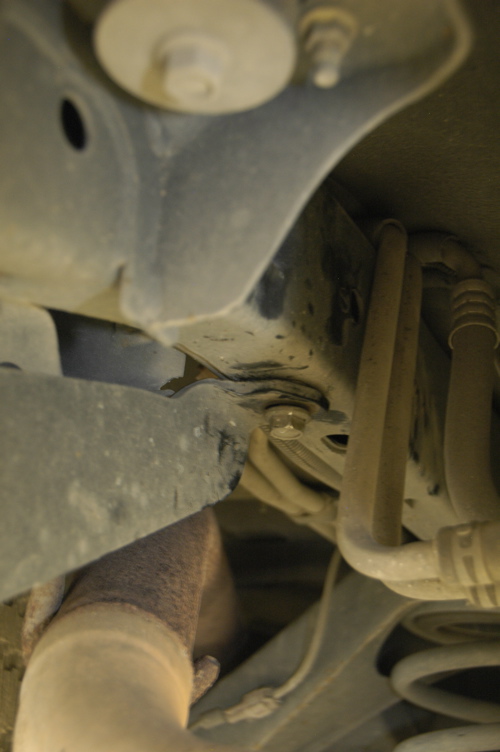 I’ll get the maintenance item out of the way first. The forward right-hand bolt on the receiver hitch that I spoke of yesterday is not broken. It threads into a “blind nut” that is welded inside the frame. Apparently at some time in the recent past, the blind nut broke its weld, and the bolt loosened.
I’ll get the maintenance item out of the way first. The forward right-hand bolt on the receiver hitch that I spoke of yesterday is not broken. It threads into a “blind nut” that is welded inside the frame. Apparently at some time in the recent past, the blind nut broke its weld, and the bolt loosened.
With the nut no longer attached to the frame, there’s no way to tighten or loosen the bolt. We can’t reach the nut because it is inside a fully boxed frame member. The nut just spins inside the frame when we turn the bolt.
Moreover, during investigation we found that the other forward bolt (on the left hand side) has the same problem. The weld holding that nut has broken as well, so that when we went to tighten it, it just spun. And the remaining four bolts were all looser than they should have been, although still well attached.
So the Armada now has a service appointment at the local Nissan dealer for next week. Both the Airstream and the Nissan are going in on Tuesday. With only four bolts really holding the hitch on, however, the Nissan is not fit to tow the Airstream. We are planning to borrow a Suburban from our hosts to shuttle the Airstream to its appointment, and we are borrowing a driver to shuttle the Nissan to its appointment, and Eleanor will follow in the Honda to move people around from one place to another. Somehow we will make it all work.

With that resolved, we are going to just enjoy the local area for the rest of the long weekend. New Hope and nearby Lambertville are interesting towns surrounded by beautiful countryside. Our courtesy parking spot by itself is absolutely gorgeous, with long sweeping views across green fields, deer near the edge of the trees, and geese hanging around the pond.
We dropped in on a locally famous old flea market this morning, and tomorrow we’ll check out more of the area. It looks like we may not go to Philadelphia after all. It’s a longish drive and there’s more than enough right here to keep us occupied.
May 23, 2008 at 9:56 pm · Filed under Maintenance
One advantage of using our trailer frequently is that we get to know it very well. We know exactly what to expect from it, and when something is not right it’s usually very apparent. We anticipate the stance it takes when it sits in a campsite with all tires fully inflated. I know the “happy noises” the truck, hitch, and brakes make when they are operating normally. I recognize the “seat of the pants” sensations that come with accelerating, turning, braking, and bumps. Everything flows along like a familiar song, which is what you want, because it sensitizes you to any off key notes.
A few weeks ago, in Florida, I started to hear an odd little squeak during towing. It was very faint, just the slightest hint of metal parts gently rubbing. It was a new sound, and new sounds are not welcome in the trailer song. So in Fort Wilderness, I took apart the Hensley hitch, thinking it needed lubrication on the tow ball (a procedure we do at least annually). But that didn’t solve it.
The noise wasn’t loud and it didn’t sound “expensive” but it bugged me because it shouldn’t have been there at all. It re-appeared again from time to time, and when it did I’d wiggle various things on the hitch, trying to find something a bit loose, needing lubrication, cracked or perhaps rusted. I also crawled under the Armada to look for cracks in the hitch. But I couldn’t find any cause for the the noise.
What was really maddening is that the sound seemed to have no pattern. Sometimes it was there, and then it was not. I’d hear it when the trailer was gently jiggling over slightly rough pavement, but on really bumpy roads it would go away. I’d hear it at slow speeds sometimes, but not when going fast. It was just soft enough that if I turned on the radio I wouldn’t hear it, but I couldn’t do that. It wasn’t supposed to be there.
Today I heard it again during our tow up from Assateague State Park to I-95. Finally, at a rest area in Pennsylvania I stood on the hitch and bounced it up and down, and after a few bounces I was rewarded with the squeak. It was coming from under the Armada.
So I got Eleanor to stand on the hitch and bounce up and down while I crawled under the truck again … and I heard the squeak coming from the factory Class V tow hitch. It has six large bolts which attach it to the truck frame, three on each side. I looked very closely, and compared one side of the hitch to the other. Finally, I saw that the hitch was not contacting the frame on the right side as tightly as it should have in the area of the forward-most bolt. There was a 1/8″ gap between hitch and frame at that point.
It was hard to see even with a flashlight (because a hot exhaust system was blocking my view) but it appears that the bolt may have broken at the stem, or stripped out of the frame. That’s very bad. Very very bad.
How bad? Well, it’s a good thing that the Nissan engineers designed a lot of redundancy into this hitch design. If not, the remaining two bolts on that side could have failed at any time in the last 1,000 miles of towing, causing the hitch to partially separate from the truck. Then, the Airstream would have been an 8000 lb anchor with a mind of its own, pushing asymmetrically on the Armada.
Ever see those cop shows when they give a little push on the bumper of the bad guy’s car, and it goes spinning out of control? Imagine that with a 30-foot trailer attached. You don’t want that to happen.
And all that from a little squeaking sound.
So here’s the moral of the story: learn the song your rig sings as it goes. Know how it sits, how it rides, and what it does at every turn. A little squeak may be all the warning you get, but it will be enough if you are in tune with your rig.
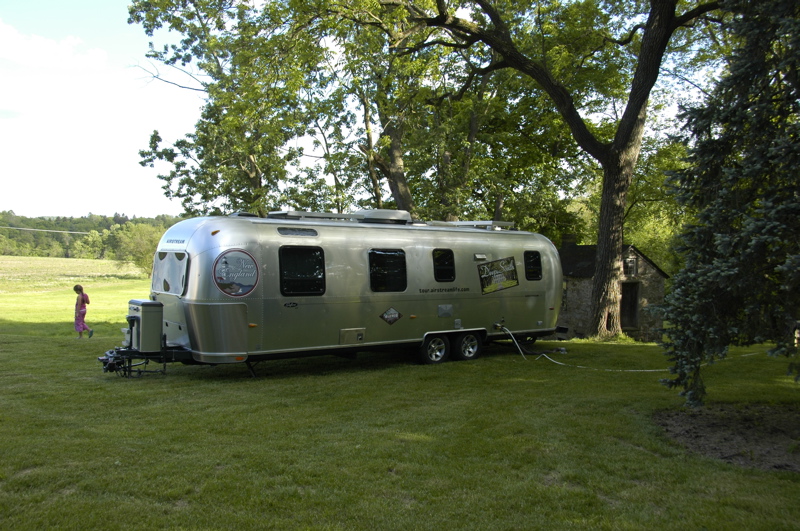
Things like this seem to always happen on the Friday before a three-day weekend, don’t they? Fortunately we were near Star & Peter’s house when we discovered the issue, and Peter is a master mechanic with an incredible workshop. We’re parked on their lawn with a full hookup now. Tomorrow we will get a good look at the problem and I am pretty sure Peter will be able to fix it. I’ll get photos for the blog and post them over the weekend.
« Previous entries ·
Next entries »
 Despite being the largest “cat” heater I could get, the unit fits nicely in a spot right in the center of the Airstream. It is hung on the wall, looking like a black monolith from 2001: A Space Odyssey where it won’t interfere with traffic flow and uses a relatively “dead” space. For a catalytic heater in a long trailer, a center location is ideal because the heat it produces needs to be distributed by natural air flow through the trailer.
Despite being the largest “cat” heater I could get, the unit fits nicely in a spot right in the center of the Airstream. It is hung on the wall, looking like a black monolith from 2001: A Space Odyssey where it won’t interfere with traffic flow and uses a relatively “dead” space. For a catalytic heater in a long trailer, a center location is ideal because the heat it produces needs to be distributed by natural air flow through the trailer. Microsoft Office installed on one computer, an external wifi card installed on Susanne’s computer, and cable Internet installed in his house with a wifi router. None of those are normally difficult tasks if you know what you’re doing, but Microsoft and the local cable company did manage to make everything harder than it had to be. By the time we’d been to Best Buy, the cable company local office, the shop, and his home, and installed everything, it was 6 p.m.
Microsoft Office installed on one computer, an external wifi card installed on Susanne’s computer, and cable Internet installed in his house with a wifi router. None of those are normally difficult tasks if you know what you’re doing, but Microsoft and the local cable company did manage to make everything harder than it had to be. By the time we’d been to Best Buy, the cable company local office, the shop, and his home, and installed everything, it was 6 p.m. At the end of it all I was glad to be rolling down the road again, headed to home base with leaks fixed and heater installed. Lake Champlain was glassy calm and hardly anyone was on the ferry. The Airstream just seemed to serenely float across the lake on the top of the ferry platform, enjoying its semi-private ride past cruise boats and jumping trout, while the sun slowly set over the Adirondacks. I’ve parked it in the usual spot and set up camp for the next two weeks.
At the end of it all I was glad to be rolling down the road again, headed to home base with leaks fixed and heater installed. Lake Champlain was glassy calm and hardly anyone was on the ferry. The Airstream just seemed to serenely float across the lake on the top of the ferry platform, enjoying its semi-private ride past cruise boats and jumping trout, while the sun slowly set over the Adirondacks. I’ve parked it in the usual spot and set up camp for the next two weeks.











